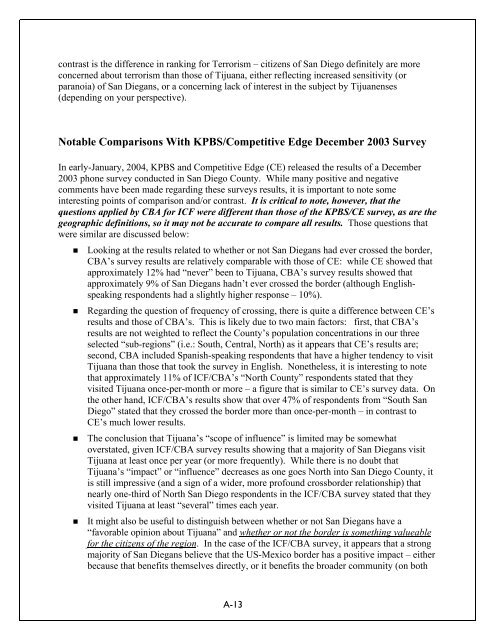Blurred Borders - International Community Foundation
Blurred Borders - International Community Foundation
Blurred Borders - International Community Foundation
You also want an ePaper? Increase the reach of your titles
YUMPU automatically turns print PDFs into web optimized ePapers that Google loves.
contrast is the difference in ranking for Terrorism – citizens of San Diego definitely are more<br />
concerned about terrorism than those of Tijuana, either reflecting increased sensitivity (or<br />
paranoia) of San Diegans, or a concerning lack of interest in the subject by Tijuanenses<br />
(depending on your perspective).<br />
Notable Comparisons With KPBS/Competitive Edge December 2003 Survey<br />
In early-January, 2004, KPBS and Competitive Edge (CE) released the results of a December<br />
2003 phone survey conducted in San Diego County. While many positive and negative<br />
comments have been made regarding these surveys results, it is important to note some<br />
interesting points of comparison and/or contrast. It is critical to note, however, that the<br />
questions applied by CBA for ICF were different than those of the KPBS/CE survey, as are the<br />
geographic definitions, so it may not be accurate to compare all results. Those questions that<br />
were similar are discussed below:<br />
� Looking at the results related to whether or not San Diegans had ever crossed the border,<br />
CBA’s survey results are relatively comparable with those of CE: while CE showed that<br />
approximately 12% had “never” been to Tijuana, CBA’s survey results showed that<br />
approximately 9% of San Diegans hadn’t ever crossed the border (although Englishspeaking<br />
respondents had a slightly higher response – 10%).<br />
� Regarding the question of frequency of crossing, there is quite a difference between CE’s<br />
results and those of CBA’s. This is likely due to two main factors: first, that CBA’s<br />
results are not weighted to reflect the County’s population concentrations in our three<br />
selected “sub-regions” (i.e.: South, Central, North) as it appears that CE’s results are;<br />
second, CBA included Spanish-speaking respondents that have a higher tendency to visit<br />
Tijuana than those that took the survey in English. Nonetheless, it is interesting to note<br />
that approximately 11% of ICF/CBA’s “North County” respondents stated that they<br />
visited Tijuana once-per-month or more – a figure that is similar to CE’s survey data. On<br />
the other hand, ICF/CBA’s results show that over 47% of respondents from “South San<br />
Diego” stated that they crossed the border more than once-per-month – in contrast to<br />
CE’s much lower results.<br />
� The conclusion that Tijuana’s “scope of influence” is limited may be somewhat<br />
overstated, given ICF/CBA survey results showing that a majority of San Diegans visit<br />
Tijuana at least once per year (or more frequently). While there is no doubt that<br />
Tijuana’s “impact” or “influence” decreases as one goes North into San Diego County, it<br />
is still impressive (and a sign of a wider, more profound crossborder relationship) that<br />
nearly one-third of North San Diego respondents in the ICF/CBA survey stated that they<br />
visited Tijuana at least “several” times each year.<br />
� It might also be useful to distinguish between whether or not San Diegans have a<br />
“favorable opinion about Tijuana” and whether or not the border is something valueable<br />
for the citizens of the region. In the case of the ICF/CBA survey, it appears that a strong<br />
majority of San Diegans believe that the US-Mexico border has a positive impact – either<br />
because that benefits themselves directly, or it benefits the broader community (on both<br />
A-13















